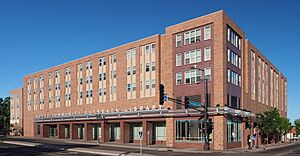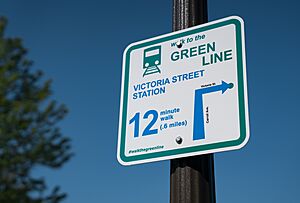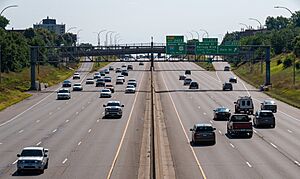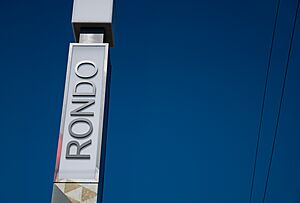Rondo neighborhood facts for kids
Quick facts for kids
Rondo
|
|
|---|---|

Rondo Community Outreach Library, 2016
|
|
| Country | United States |
| State | Minnesota |
| County | Ramsey |
| City | Saint Paul |
| Time zone | UTC-6 (CST) |
| • Summer (DST) | UTC-5 (CDT) |
The Rondo neighborhood is a historic area in Saint Paul, Minnesota. For many years, Rondo was a very important place for the Black community in the Twin Cities area. It was a lively center for homes and culture.
However, a big change happened between 1956 and 1968. A major highway, Interstate 94, was built right through the heart of Old Rondo. This construction caused over 650 families to lose their homes. Many businesses and community places were also destroyed. Even though the highway changed Rondo forever, the neighborhood still has a strong cultural identity. People today still talk about how the highway affected Rondo's residents.
Contents
About the Rondo Neighborhood
The Rondo neighborhood is located in Saint Paul, Minnesota. Since the late 1800s, it has been a vital center for the Black community. Rondo grew into a diverse community with many different kinds of people. It was supported by social clubs, churches, community centers, and busy local businesses.
Sadly, a large part of Rondo was destroyed between 1956 and 1968. This happened to make way for the Interstate 94 freeway. Families and businesses were forced to leave their homes and shops. This displacement had a very negative impact on the Black community in the Twin Cities.
Rondo's Location and Changes
In 1950, Rondo had clear borders. It stretched from Lexington Avenue in the west to Rice Street in the east. To the south was Marshall Avenue, and to the north was University Avenue.
The Interstate 94 freeway now runs east-west through the area. It was built between what used to be Rondo Avenue and St. Anthony Avenue. These two streets used to run side-by-side. When I-94 was built, it took parts of both Rondo Avenue and St. Anthony Avenue. The remaining parts of these streets became smaller service roads. Rondo Avenue was even renamed Concordia Avenue.
Today, four bridges cross over I-94. They help connect the two parts of what was once the Rondo neighborhood. These bridges are at Lexington Avenue, Victoria Avenue, Dale Avenue, and Western Avenue. East of Western Avenue, Saint Paul College built a new campus in 1966.
The area south of I-94 became part of the Summit-University neighborhood. The Frogtown neighborhood starts north of University Avenue.
Rondo's Rich History
Early Black Community Life
Rondo was the heart of the Black community in St. Paul. Many Black families owned their homes in Minnesota starting in the 1900s. Important organizations were formed in Rondo. These included the St. Paul chapter of the National Association for the Advancement of Colored People (NAACP). Famous civil rights leader Roy Wilkins was involved here.
Black newspapers also thrived in Rondo. Some of these were the St. Paul Echo, the Appeal, and the St. Paul Recorder. The St. Paul Recorder is now known as the Minnesota Spokesman-Recorder.
Other important community resources in Rondo included the Urban League and the Hallie Q. Brown Community Center. These places helped people in many ways.
Baseball was also a big part of Rondo's history. Many famous players came from or played in Rondo. Toni Stone was one of only three women to play in the Negro leagues in the 1950s. Roy Campanella, a Hall of Fame catcher, lived in Rondo in the late 1940s. Dave Winfield, another Hall of Fame outfielder, grew up in Rondo. His family had to move because of the highway construction.
Building the Interstate 94 Highway
In 1956, the Federal Aid Highway Act of 1956 provided money to build freeways across America. This was because more people were using cars. There were different paths the highway could take through St. Paul. One option was further north, along old train tracks. However, the route chosen went right through Rondo, which was a mostly Black neighborhood.
Looking back, many agree that building the highway through Rondo caused a lot of harm. This harm affected the people of Rondo much more than others. The Black community in Rondo became weaker. Some residents moved to other areas in the Twin Cities. Those who stayed had fewer Black-owned businesses nearby. The freeway also cut the neighborhood in half.
The highway route also separated the Minnesota State Capitol building from downtown St. Paul. It also caused some problems for the Prospect Park neighborhood in Minneapolis.
Light Rail Transit and Community Efforts
Years later, when the Green Line light rail system was planned, people remembered Rondo's history. The Green Line was set to run on University Avenue, close to I-94. This meant the same communities might be affected again. Groups formed to make sure history did not repeat itself.
Melvin Carter, who later became St. Paul's mayor, worked to improve the Green Line project for Rondo. Groups like the NAACP and local residents filed a lawsuit. They argued that the planners did not do enough to help poor people and minorities. They worried about repeating Rondo's past.
Because of these actions, three new light rail stops were added to help Rondo and Frogtown residents. More money was also given to help with parking and business losses during construction. The Federal Transit Administration also changed its rules. They started to consider social fairness and community well-being more when planning transportation projects.
Reconnecting the Community
In 2016, leaders from the MNDOT and St. Paul formally apologized. They said they were sorry for how the interstate construction was handled.
Since the 2000s, people have discussed building a "land bridge" over I-94. This bridge would cover the highway and reconnect the two halves of Rondo. A new federal program, 'Reconnecting Communities', also aims to fix harm caused by old transportation projects. This program supports ideas like pedestrian walkways over freeways. The Rondo Land Bridge idea is being discussed in Minnesota. It could create 15 to 21 acres of new land over I-94.
Rondo's Lasting Legacy
Rondo Days is a special weekend celebration. It honors the spirit of the Rondo community. It first started in 1983. Two important Black community members, Marvin Roger Anderson and Floyd G. Smaller, created an organization called Rondo Avenue Inc. They wanted to keep Rondo's history alive. They launched the yearly festival in 1982. The event has grown to include a parade, a senior supper, and a drill and drum competition.
In 2006, the St. Paul Public Library opened a new building. It is called the Rondo Community Outreach Library. It has special collections about Rondo's history.
Macalester College in St. Paul has worked with Rondo Avenue, Inc. They teach a course about Rondo's history. Students from the High School for Recording Arts also made a documentary called Rondo: Beyond the Pavement. The work to reconnect Rondo continues today.
In 2017, three artists created a public art project called Rondo Family Reunion. They collected stories from Rondo residents. They displayed these stories on lawn signs with old photos and poems. The project ended with a printed book.
The Rondo Commemorative Plaza was built in July 2016. It is on Old Rondo Avenue (now Concordia Avenue). It has an exhibit about Rondo's story, benches, and a performance area. It also has a tall tower with a light that can be seen from I-94.
In 2017, the Minnesota History Theater presented a play called The Highwaymen. It explored how the freeway construction affected the neighborhood.
The history of Black baseball in Rondo is also remembered. It is part of the St. Paul Saints City of Baseball Museum. The museum shows how important Black baseball was to St. Paul's history.
In 2022, the Hallie Q. Brown Community Center released a board game. It is called Rondo-opoly. The game teaches players about Rondo's history. It uses details from the center's archives to highlight important historical places in Rondo.
Notable People from Rondo
- Reverend Robert Hickman (1830 – 1900), a community founder
- Roy Wilkins (1901 – 1981), a famous Civil Rights activist
- Toni Stone (1921 – 1996), a pioneering female professional baseball player
- Dave Winfield (born 1951), a Hall of Fame professional baseball player
- Stacy Robinson (1962 – 2012), a professional football player
- Melvin Carter (born 1979), current Saint Paul mayor
- Dua Saleh, a musician and actor







